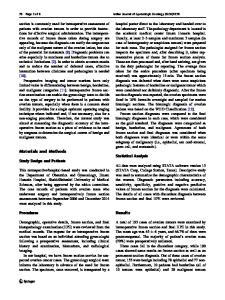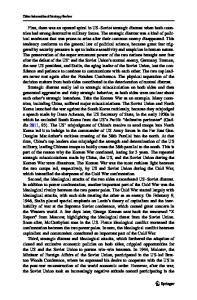Do we need special viewpoints for intraoperative frozen section diagnosis?
- PDF / 150,677 Bytes
- 2 Pages / 595.276 x 790.866 pts Page_size
- 116 Downloads / 333 Views
COMMENTARY
Do we need special viewpoints for intraoperative frozen section diagnosis? Tomio Arai 1
# Springer-Verlag GmbH Germany, part of Springer Nature 2020
In this issue of Virchows Archiv, Zhu and colleagues report the useful morphologic features of poorly cohesive gastrointestinal carcinoma and signet-ring cell adenocarcinoma based on intraoperative frozen sections to avoid misdiagnosis [1]. These carcinomas show invasive growth within the wall, and the extent of a tumour may not be sufficiently recognised macroscopically. Therefore, frozen section diagnosis is necessary to determine if a tumour has been sufficiently resected at the surgical margin. Since prognosis improves with additional resection in cases of positive margins, correct diagnosis is essential. However, evaluation is sometimes difficult using only intraoperative haematoxylin-eosin (HE)-stained specimens. Intraoperative frozen section diagnosis of stumps shows only a limited tumour area in a conventional histopathological examination, potentially causing a false-negative evaluation. To avoid this, as many sections as possible should be prepared. Correct diagnosis is often difficult because intraoperative frozen sections are less accurate for diagnosis compared to permanent sections. It is difficult to prepare suitable frozen sections for tissues that contain a large amount of fat. Fatty tissue exists in the subserosal layer, making it difficult to acquire appropriate HE-stained slides. However, poorly cohesive carcinoma tends to infiltrate the subserosal layer with fibrous stroma. By devising this, it is possible to obtain a specimen that can withstand diagnosis. Pathologists engaged in intraoperative frozen section diagnosis should rely on small specimen findings and also establish diagnoses based on other information such as preoperative biopsy results, macroscopic findings, surgical findings, and clinical information. It is important to be aware of the * Tomio Arai [email protected] 1
Department of Pathology, Tokyo Metropolitan Geriatric Hospital and Institute of Gerontology, 35-2 Sakaecho, Itabashi-ku, Tokyo 173-0015, Japan
positional relationship between the sampling site and lesion to establish a correct diagnosis. Intraoperative diagnosis requires the cooperation of clinicians. This preliminary diagnosis provides an indication for treatment and is not necessarily the final diagnosis. Frozen section diagnosis requires more careful observation of the overall structure and cell atypia than that required for permanent specimens. In advanced poorly cohesive adenocarcinoma, cancer cells tend to spread laterally through lymphatic vessels which cannot be macroscopically discriminated. In these cases, the entire stomach wall must be excised and examined because cancer cells can invade only the muscularis propria and/or subserosal layers. If only the mucosal and submucosal tissues are excised as specimens for frozen sections, the false-negative risk increases. When submucosal or deeper infiltration near the stump is suspected, the stump should
Data Loading...











